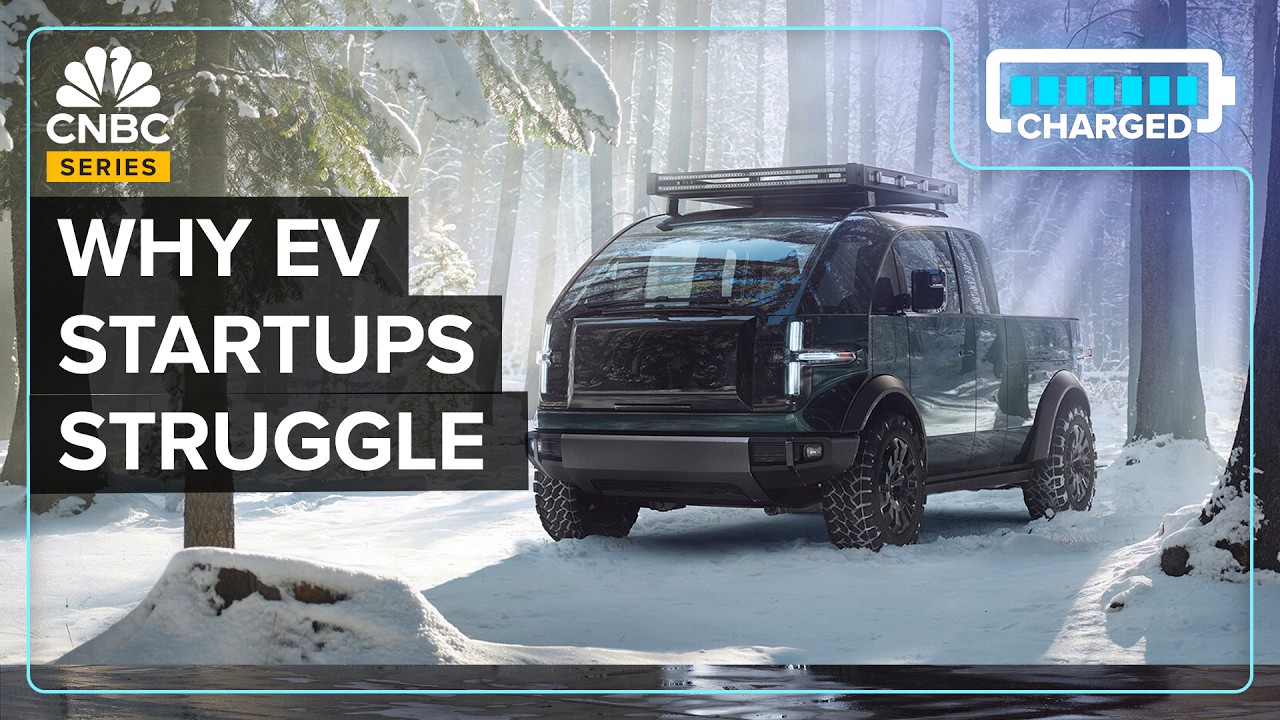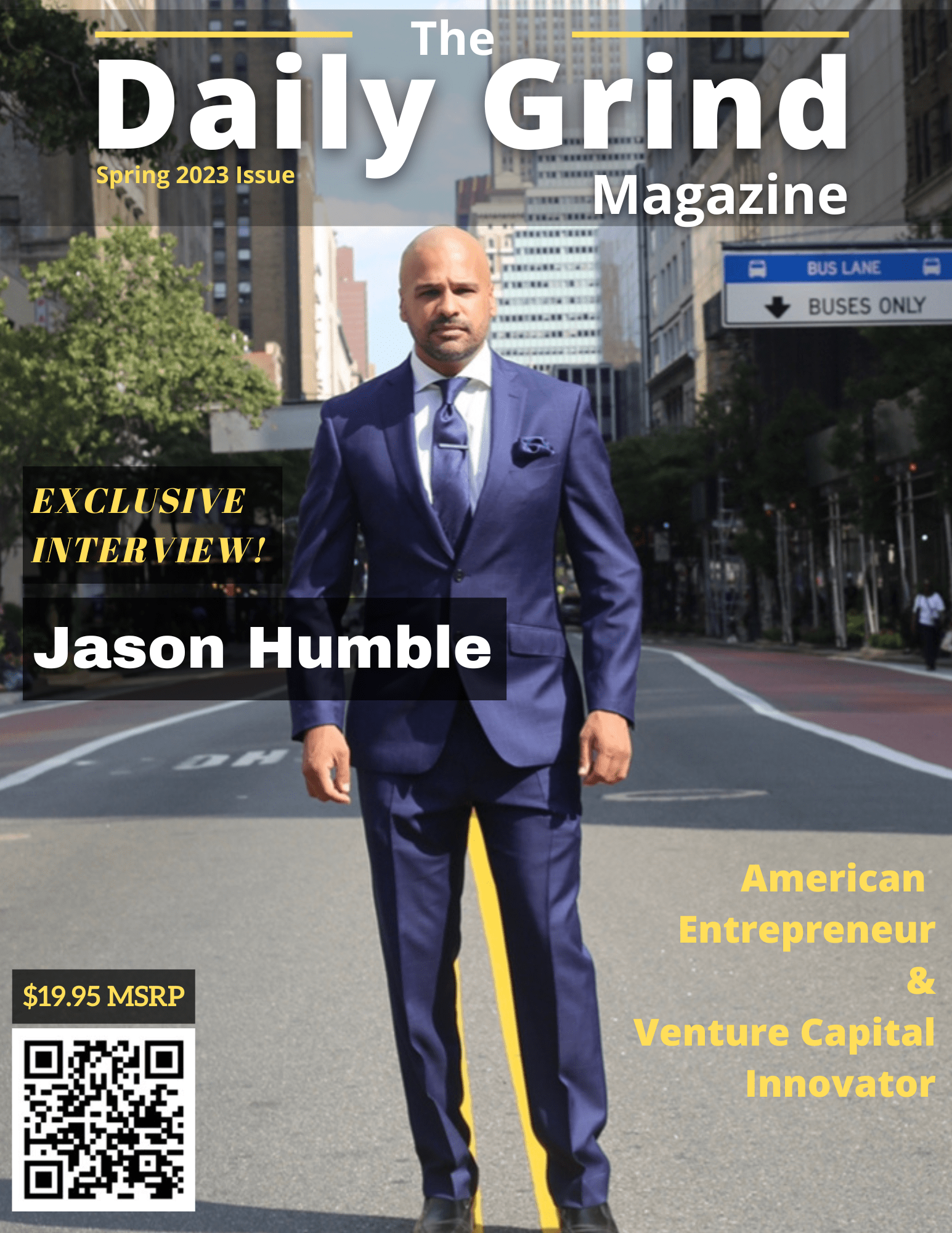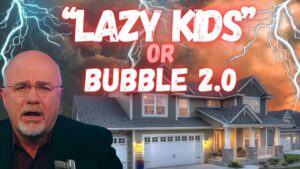The EV revolution has
offered entrepreneurs the Chance to make history and,
at times, piles of money. Elon Musk's wealth
skyrocketing thanks to a Surge in Tesla shares. So I present to you the
Cybertruck. But in this race to seize
the moment, many contenders Are sputtering. Several high profile
companies have failed, gone Bankrupt or fought struggle
after struggle. Even established players in
other industries with Automotive dreams have
thrown in the towel. In recent years, more than
30 companies have filed for Or are at risk of
bankruptcy. The total addressable EV
market is huge. Tesla, which controlled
more than 50% of it in the US in 2023, sold more than
650,000 vehicles in the Country and raked in more
than $82 billion in vehicle Sales and leasing revenue
worldwide. And EVs made up just 8% of
US new car sales that year. They're expected to be 46%
by 2030. That's nearly 8 million
vehicles. But the business is not for
the faint of heart. It takes billions and
billions. Hopefuls have routinely
underestimated those capital Costs. A company has to put
together a complex supply Chain, build factories,
design the vehicles, comply With regulations and get
them to customers through a Distribution and service
network. So why is it so difficult
to start an EV company and Why are so many failing? To be sure, despite talks
of sales slowdowns, Forecasts are still
charting a boom in EV Adoption around the world,
from 2.4% of new cars sold In 2019 to 61% by 2035.
Startups, by definition,
love vast addressable Markets. This is venture
capital pitch. You know, slide number one. And by the way, it's not
only light duty vehicles, it Is also busses, trucks,
motorcycles. And in the, you know, even
more distant future Aircraft. Ev investment commitments
have doubled in value in Just two years, reaching
$616 billion through 2027. Enthusiasm like this is
what allowed for the Creation and success of
Tesla, basically the first Major EV automaker outside
of Asia. The growth of the market is
partly supported by Favorable government
policies. Countries eager to Decarbonize offer a range
of incentives, subsidies, And other perks to help
defray the cost of getting Started. Since 2021, Tesla
has pulled in more than $5 Billion in zero emission
vehicle credits. Those are credits other
automakers have to buy from Tesla or other EV, or plug
in makers every time they Want to sell a fuel burning
vehicle. In some states. You know, China's had this
fastest growth in electric Vehicles of of anywhere. And that's also supported
with a lot of of of Government policies. So, you know, some of the
places where there's a Proliferation of new
companies, it's been pushed, You could say with help
from the government, some of It is the entrepreneurs
wanting to grab the Opportunity of this change
in the dominant design to Electric. But this time of tremendous
growth and opportunity has Also coincided with several
high profile failures.
Apple, one of the largest
companies in the world by Market value, folded its
car project, known within The company as Titan. Dyson, the privately held
British firm best known for Bagless vacuum cleaners,
ditched its electric car Plans after it decided it
couldn't make money off Them. I mean, those are two
businesses coming from super High profitability, super
high return on capital. I kind of agree with them. If you're going to come
into automotive, you better Come with some serious
innovation. Indifference. Bringing a car to market
requires a mix of Engineering and design
talent and ability to Execute, actually securing
manufacturing space and Suppliers, confronting
stringent and complex Regulations, and actually
bringing something new to The table. Even if you start with an
advantage, you have the Clean sheet of paper
opportunities that startups Have. You have to learn all
these really hard things That the big automakers do. You know, you have to learn
to to design, and you have To learn to build a supply
chain. You have to learn to
manufacture. You have to Learn to sell and just and
deal with repair and Maintenance and after sales
service and all that. But above all, it takes
capital. Just look at the capital
returns, not the stock Prices. The the actual
returns on capital, they're Not very attractive. This is a highly capital,
intense competitive Industry.
Returns on invested capital
for established automakers Like Ford and GM are in the
mid single to low double Digits for 11 of its 15
years as a public company. Tesla's returns on invested
capital were negative. Plain and simple. Companies just run out of
money. Fisker experienced an old
fashioned cash crunch. Some of that was inherent
in the capital intensity of Becoming an an automaker,
but some of it was also due To mistakes that that the
company made. Running out of capital is
the biggest problem an Automaker has. That might
seem obvious. It is, of course, the
problem every business Faces, but the capital
costs of starting an Automaker are massive. Yes, you're two ish billion
to get to your first Vehicle. Not everybody has $2 billion
to play with. And frankly, even if 2
billion is available, that's Not a guarantee of success. That's really just the
beginning. You need to be like a shark
where you're always moving Or you die if you stand
still. So there needs to be an
ability to to raise the next 2 billion and the next 2
billion after that. Take Rivian and Lucid. Both of them have
eviscerated $10 billion. So interesting to see these
other small startups who Raise 1 billion or 2
billion. And they think that's
enough. It's not even close. This was a problem faced by
a lot of the startups that Went public using special
purpose acquisition Companies, or SPACs.
A Spac is a public shell
company that merges with a Private business, in this
case an EV firm. And through that merger,
the private company becomes A public one. There is no venture capital
firm on the planet that will Write billion dollar checks
to to an EV startup. So to raise that kind of
money, the only realistic Scenario is to become a
public company. For EV startups, a SPACE came with a few advantages Over the traditional IPO. For example, you could go
public using projected Revenue rather than actual
revenue. The SPAC promise, at least,
was that these companies Could turn to markets for
the funding they'd need to Grow. It hasn't really been the
story. It's not like retail
investors dumped a bunch of Money into Tesla. This is
like Daimler and others that Put money in when it was
needed, and then debt and Other things. You know, the
companies that are Pre-revenue, you know,
typically shouldn't be Public companies. It's very hard for a
company that's pre-revenue To stay ahead of the bow
wave and, and have people Interested in, in investing
and putting billions of Dollars more into a
startup. So what are all those
billions of dollars going to To start budget? About 500 million to 1
billion to build a plant and Tool it, then about 200
million and half a billion On top of that in supplier
tooling, and another 250 to 500,000,000in product
development costs. There are certain fixed
costs associated with Building and running a
factory and tooling it.
Once you have built and
tooled a factory, you have To produce a certain number
of vehicles in order to Absorb those fixed costs. The person selling the parts
will say, well, look, I've Got this big fixed cost. I spent $50 million to be
able to make you 200,000 Vehicles. You're only
asking for 20,000 vehicles. I need my money and then
say, well, sorry, we don't Have any, like. Okay, well,
sorry, you don't get parts. Then you need about 100 to
$200 million a year just to Keep everything running
while you were waiting to Launch vehicles. Once you
launch, you have to put more Growth capital into the
business to fund the second Vehicle and possibly the
second plant to build that Vehicle. Companies choose
different approaches. Vertical integration is
basically doing everything Yourself, or at least as
much as possible. Another way to do things is
to outsource some or most of The work. Some start with
what is called a donor Vehicle, basically a
repurposed vehicle or a set Of components from an
existing manufacturer, like A chassis or powertrain. Lordstown started with a
donor body on its endurance Pickup truck. Elms started
with a Chinese van. This can save you the
trouble of having to build Something from scratch, but
it can come with downsides, Like the degree to which
you can change the vehicle And customize it is
somewhat limited. There is also the asset
light approach favored by Companies like Fisker use
outsiders like suppliers or Contract manufacturers to
make the vehicles you Design. It might look like
a company is saving a lot of Money by paying an
experienced outside firm to Make the car in a factory
already built, but costs add
Up. Alixpartners Mark
Wakefield says bringing a Vehicle model from design
to rolling reality can take Anywhere from 2 to 4 times
the number of hours Expected. You never design it once,
and it's right. Electric vehicles escape the
burden of emissions Regulations, but there is
still a host of other rules They have to comply with,
perhaps most notably the Federal Motor Vehicle
Safety Standards, or Fmvss For short. The barriers to entry on
things like Fmvss are Aggressive, are tough, and
they're tough because these Are things that can kill
people and kill people Immediately. But a car also has to be
refined enough to Comfortably drive. And there's all these
complex interdependencies Around vibration and
around, you know, things That matter to drivers. Macduffie is referring to a
concept called noise, Vibration, and harshness. A carmaker has to ensure
all of the components in a Car are fitted together
perfectly. If not, you get intolerable
levels of all three. Every automaker that's ever
succeeded is doing Constantly doing a lot of
this fine tuning. Tesla probably does a
little less of it, and some People will complain about
that. You know, the fit and
finish isn't as good. The gaps aren't so clean,
things look a little shoddy, And so far people haven't
cared because they they love The power. They love the
big screen, they love the Software. Like there has to be a
reason to buy this vehicle.
And a lot of the startups
were trying to be first Mover, so there wasn't a
tremendous amount of Innovation that a consumer
actually feels more Stylistically different. Some of them had challenges
because the delays they had In getting to market. By that time, there was
other vehicles actually in The market too, that were
very similar, and now they Weren't the they weren't
the first mover and the only Game in town. This is a huge source of
tension. Perhaps the fundamental
problem any EV startup or Any auto startup will face. Got this dichotomy of you
need to change stuff and be Different, but there's a
lot of tried and true that's In existing vehicle designs
and approaches and Validation methods that you
take risk when you don't do Those things. I mean, the
less innovative you are, the Lower that bill can be, but
then the less innovative you Are and different you are,
the less reason there is for Someone to actually care
about your product and value You at anything. There is no exact recipe for
success. Us data shows EV demand is
stagnating. Tesla missed even the most
bearish delivery targets for The first quarter of 2024. Shares have fallen nearly
35% since the beginning of The year. Then again, rival
Rivian's first quarter Deliveries were better than
expected. In some ways, today looks a
lot like the early days of The auto industry. At that
time, there were hundreds of Small companies, mostly
clustered around Detroit, The center of the business. But in a very short time, a
decade or so, the vast
Majority of those were gone
and only a few survived. Those are more or less the
same big three that exist Today GM, Ford and the
remnants of the Chrysler Corporation, which has
merged with the Fiat and Peugeot Empires to form
Stellantis. Some of that consolidation
occurred as automakers made Advances in achieving
economies of scale for the Manufacturing of final
vehicles, but there was also A lot of vertical
integration bringing Suppliers inside. General Motors is known for
consolidating several brands Such as Chevrolet,
Cadillac, Buick and the now Defunct Oldsmobile and
Pontiac, but it also brought A lot of outside suppliers
in-house. Gm's legendary CEO, Alfred
Sloan, even came into the Company through a supplier
acquisition and then rose Through the ranks. But in
the latter half of the 20th Century, automakers began
spinning out their supplier Businesses in an effort to
become leaner and focus on Simply making the final
product. Today, that trend appears
to be reversing. Tesla and BYD are two of the
most vertically integrated Firms in the world. They
are deciding that it's much Better. You get much more
control, you get much more The right pieces to fit
into a total vehicle. If you do it yourself. You generally have more
flexibility if you're doing It yourself. But it it does
cost a horrendous amount of Money up front. They might be repeating a
pattern that the industry Saw before, and both their
market share and their Ability to survive thus far
suggests their chances of Being around in another
decade, when many of their Would be rivals have bitten
the dust.
Even if there's flurry of
and a deferment of a lot of New firms right now,
history would tell us it Won't last.






